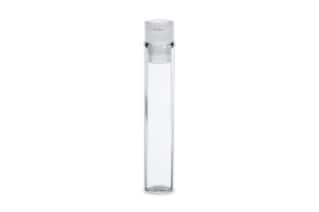
|
Certified |
LCGC Certified |
|
Closure Type |
Snap Neck |
|
Dimensions |
8 x 40 mm |
|
Material |
Clear Glass |
|
Volume Capacity |
1 mL |
|
Type |
Autosampler vial |
|
Includes |
Vial, Cap, & Septum |
|
UNSPSC |
41121806 |
|
Application |
Sample Preparation |
|
Product Type |
Vials |
|
Units per Package |
250 pk |
LCGC Certified Clear Glass 8 x 40 mm Snap Neck Vial, 1 mL Volume, 250/pk
Waters LCGC certified vials are tested by HPLC using UV detection with a test developed to identify trace levels of chemicals used in the manufacturing and packaging processes. These chemicals may include lubricants, surfactants, antistatic, and antioxidants from packaging. Each batch of vials is tested after being packaged for several days to ensure cleanliness, and an additional headspace GC test is done to look for proper curing of the silicone septa. These standards, along with the tightest dimensional tolerances in the industry, make Waters LCGC Clear Glass Vials a reliable piece of lab equipment.
These vials feature a snap neck, an extension of the crimp cap system in which a plastic cap is stretched over the rim of the vial to form a seal by squeezing the septum between the glass and the stretched plastic cap. The plastic cap then creates tension by trying to return to its original size, forming the seal between glass, cap, and septum. These caps do not require any tools to assemble.
Clear glass vials are made from Type 1, 33-Expansion Borosilicate Glass, the most chemically inert glass available, which is generally used in analytical labs in order to achieve high-quality test results. The glass has an expansion coefficient of approximately 33 x 10 (-7) C and is composed of primarily silicone and oxygen, containing trace amounts of boron and sodium.
Each order contains 250 vials, with each vial able to hold up to 1 mL of volume. Volumes can be adjusted using a Low Volume Glass Insert, 150 µL Volume, 100/pk.
What Is A Headspace GC Test?
Headspace GC, or gas chromatography, tests are the analysis of volatile and semi-volatile organic compounds that are given off by a sample during heating or over time. In the case of vials, that time elapses after packaging. This can be used to test for residual solvents, contaminants, or low molecular weight additives. This typically involves a “purge and trap” method, in which the sample is placed in a heated vessel, which is then purged with gas, which flows through to a sorbent material that collects outgassed components. These components are then flushed onto a column for analysis.